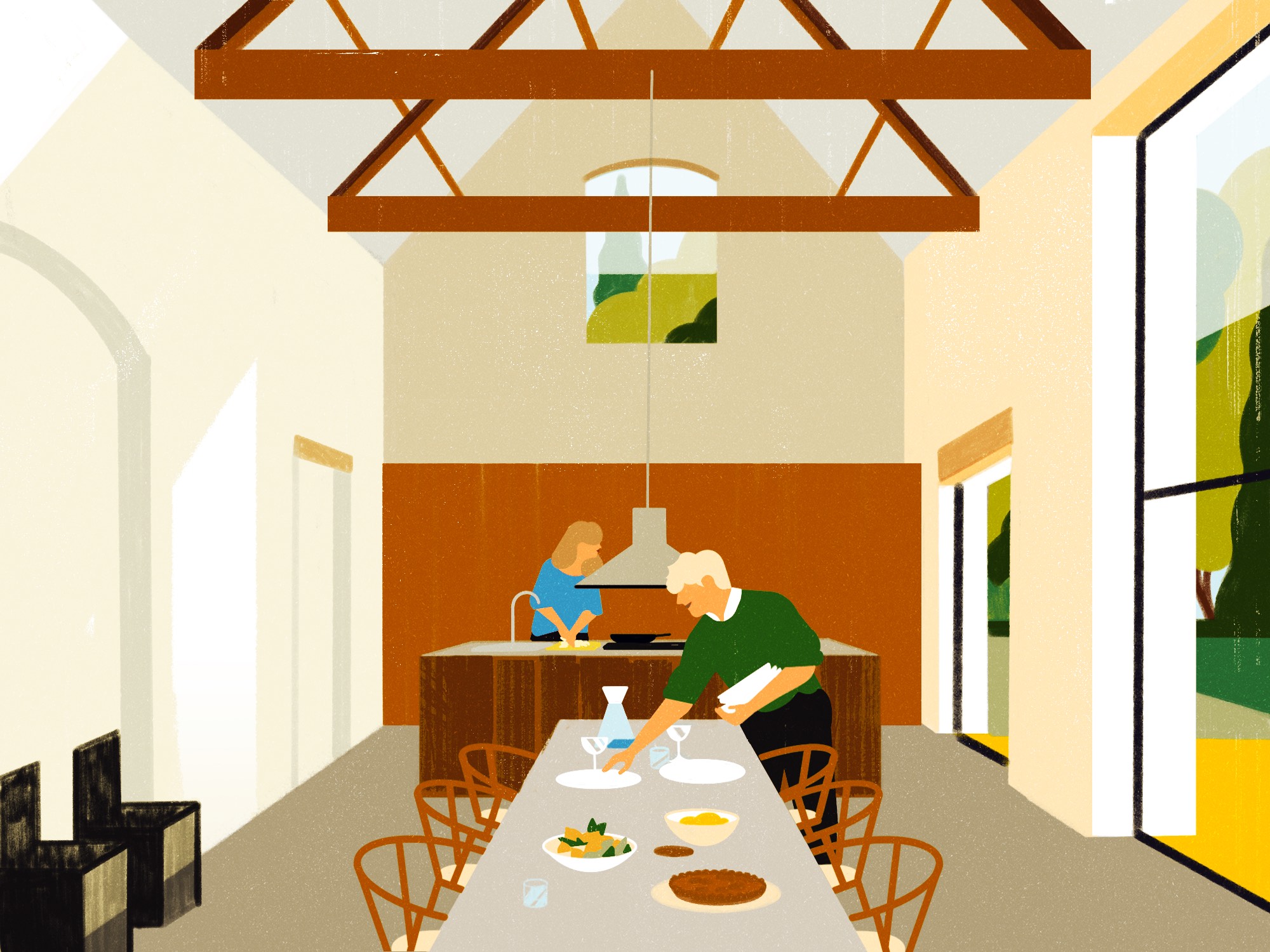Kitchen Creative is a series produced by Surface in partnership with Gaggenau that spotlights artists, architects, and designers with a passion for cooking who treat the kitchen as a sanctuary for inspiration, meditative white space, and human connection. Told in the form of as-told-to essays, the personal stories align with Gaggenau’s dedication to its foundational professional kitchen principle, which is predicated on developing intuitive technology to equip home chefs with the tools to produce restaurant-grade results. In the first two installments, interior designer Rita Chraibi waxes poetic on her multicultural approach to food and architect Stephanie Goto reveals how cooking is like designing a building. In this edition, husband-and-wife designers John and Catherine Pawson discuss family meal traditions at their sprawling 1610 farm estate in The Cotswolds.
Catherine Pawson: We bought a derelict farmstead in 2013, and by derelict, I mean literally water pouring through the ceiling. The rooms in the attic were literally curtains of cobwebs. The property hadn’t been touched for 70 years—it was a time warp. Anybody we showed the property to looked completely shocked that we would even dream of undertaking such a major project. Because it is a [heritage] listed building, the renovation took us five years.
John Pawson: We rebuilt it stone by stone.
Catherine: There is a farmhouse, a threshing barn, and then another big barn. We linked all those buildings together with a modern intervention in the middle.
John: Either by necessity or by design, the modern kitchen is the center of the home. Everything passes through it, everything happens in it, apart from sleeping and washing, I suppose. We sometimes wash the dog there, but not ourselves.
Catherine Pawson: I love to have the guests in the kitchen. In our barn, there are stools for the guests to sit around the worktop, and everybody helps. The kitchen is the beating heart of the home, where everybody moves toward. Preferably there’s music; John acts as the DJ.
John: We both like jazz, the fairly traditional Miles Davis and John Coltrane sort of thing, and then obviously the classics. But our son Caius runs a record label, so if he’s around or if we have his playlist—he represents bands like The XX, FKA Twigs, and Samphire—we’ll listen to that. We don’t like everything, but it’s certainly an ear-opener for us.
Catherine: Cooking is very therapeutic. I absolutely hate cooking when I’m under pressure to do a lot of other things. Then I don’t enjoy it at all. The ideal time to cook is a Sunday for lunch because I have the whole morning to do it in a relaxed way.
John: Although our grown-up children and I get told off if we pick at the food before it’s ready.
Catherine: That drives me nuts; I waive my knife like ‘Go, go, go!’ I’m a convert to induction cooking thanks to the Gaggenau induction cooktop, which heats up the whole cooking area evenly. I use a large kettle or griddle pan for grilling vegetables and fish. My favorite tool is the mandoline because it slices vegetables evenly and quickly. (Same with fingers, so be careful!) I also find a vegetable peeler indispensable. One of my go-to recipes right now is ricotta-stuffed pea flowers. John’s is nettle risotto with wild garlic pesto. But I’m also loving this Italian dish called vignole, which is young spring vegetables lightly stewed.
John: My abiding memories of my mother are of her at the stove, cooking these amazing meals. I’m one of five children, and our kitchen was at the bottom of the stairs where you could always smell breakfast before you saw it. And even if we had guests, I think we’d eat mostly in the kitchen, unless it was formal like Christmas or a dinner party.
Catherine: Our family meals are very similar. But the meals are, in a sense, quite old-fashioned in that John hates dinner [in front] of the TV. It just doesn’t exist in our house. He likes the table to be properly set, candles, and a proper conversation—no mobile phones.
John: It’s by mutual consent! I suppose it’s a reaction to my father, who always sat in the carving chair at the end of the table. Everyone had to give him what he thought they should have and the conversation was dictated by him and so on. So I always avoid sitting at the end of a table now and carving. I mean, I can carve, but luckily Catherine or my son carves.
Catherine: A meal is a ceremony and it’s quite a precious moment that happens three times per day. It takes a long time to prepare the food, so everything should be done well, up to the table decoration, which I quite like, but John hates it.
John: Life is a compromise! Sometimes we have flowers on the table. Can you believe it? The environment and the way you eat, how the table’s laid, the glass you drink out of—basic things like that make a difference. They’re all important. These moments are really important to mark. It sounds a bit much to have three meals per day marked, but it’s a chance for everybody to focus on each other.
Catherine: And decompress.
John: If people rush meals or don’t take the time, it’s a pity. Obviously, there are exceptions and it’s not very rigid and we try and fit in with everyone’s timing with work and so on. But during lockdown, it’s been amazing. The boys often make their own meals at lunchtime and contribute in the evenings. It’s a team thing.

